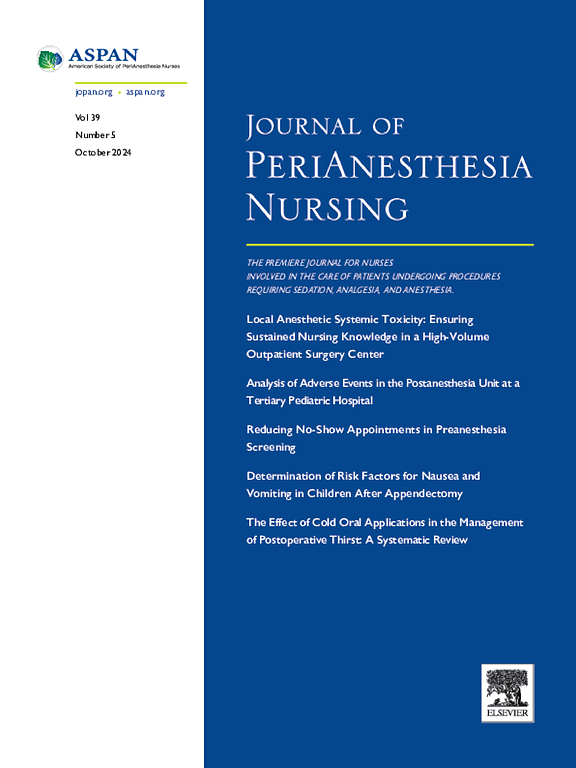术前对乙酰氨基酚治疗术后疼痛(PAPP):最新的 Meta 分析。
IF 1.6
4区 医学
Q2 NURSING
引用次数: 0
摘要
目的:术后疼痛是手术的常见后果。先期镇痛包括在手术切口前开始使用镇痛剂。这被认为是一种有助于减轻术后疼痛的简单方法,在颈椎手术等高风险人群中可能更为有效。之前的一项荟萃分析表明,预先服用对乙酰氨基酚可有效减轻术后疼痛,但证据的确定性有限。本文是一项最新的荟萃分析,对接受手术的成年患者进行了预先服用对乙酰氨基酚与手术后服用对乙酰氨基酚的比较:设计:系统综述和荟萃分析,包括一项未发表的随机、安慰剂对照、双盲试验:研究结果:我们纳入了 845 名参与者和 12 项研究:我们在更新的荟萃分析中纳入了 845 名参与者和 12 项研究。荟萃分析(包括我们的试验)发现,抢先干预组的 24 小时吗啡消耗量减少(平均差异为 -2.42 毫克;95% 置信区间为 -4.26 至 -0.59 毫克),术后呕吐减少(风险比为 0.56;95% 置信区间为 0.36 至 0.88)。在申请镇痛药的时间、6 小时和 24 小时的疼痛评分或瘙痒症方面,预先服用对乙酰氨基酚组与对照组之间没有差异。所有评估结果的证据确定性都很低:这项荟萃分析发现,预先服用对乙酰氨基酚可减少 24 小时阿片类药物的消耗量和术后呕吐。本文章由计算机程序翻译,如有差异,请以英文原文为准。
Pre-Emptive Acetaminophen for Postoperative Pain (PAPP): An Updated Meta-Analysis
Purpose
Postoperative pain is a common consequence of surgery. Pre-emptive analgesia involves the initiation of analgesics prior to surgical incision. This has been proposed as a simple method to help reduce postoperative pain, which may be more effective in higher-risk populations such as cervical spine surgery. A previous meta-analysis has demonstrated that pre-emptive acetaminophen may be effective in reducing postoperative pain although the certainty of evidence was limited. This present paper is an updated meta-analysis comparing pre-emptive acetaminophen versus postincision acetaminophen in adult patients undergoing surgery.
Design
Systematic review and meta-analysis with the inclusion of an unpublished randomized, placebo-controlled, double-blind trial.
Methods
An updated meta-analysis was conducted which searched electronic databases to identify randomized controlled trials with the same interventions.
Findings
We included 845 participants and 12 studies in the updated meta-analysis. The meta-analysis (including our trial) found reduced 24-hour morphine consumption in the pre-emptive group (mean difference −2.42 mg; 95% confidence interval −4.26 to −0.59 mg), as well as reduced postoperative vomiting (risk ratio 0.56; 95% confidence interval 0.36 to 0.88). There was no difference between pre-emptive acetaminophen and control groups for time to analgesic request, pain scores at 6 and 24 hours or pruritis. For all outcomes assessed, there was very low certainty of evidence.
Conclusions
This meta-analysis found pre-emptive acetaminophen reduced 24-hour opioid consumption and postoperative vomiting.
求助全文
通过发布文献求助,成功后即可免费获取论文全文。
去求助
来源期刊

Journal of Perianesthesia Nursing
NURSING-
CiteScore
2.20
自引率
17.60%
发文量
279
审稿时长
90 days
期刊介绍:
The Journal of PeriAnesthesia Nursing provides original, peer-reviewed research for a primary audience that includes nurses in perianesthesia settings, including ambulatory surgery, preadmission testing, postanesthesia care (Phases I and II), extended observation, and pain management. The Journal provides a forum for sharing professional knowledge and experience relating to management, ethics, legislation, research, and other aspects of perianesthesia nursing.
 求助内容:
求助内容: 应助结果提醒方式:
应助结果提醒方式:


